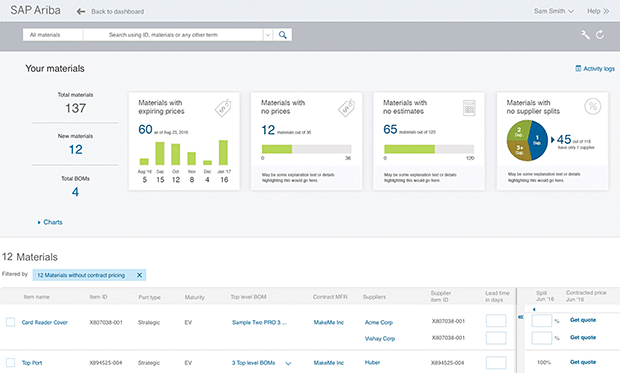Achieving a Real-Time Supply Chain Through Better Collaboration
How the Ariba Network Streamlines Processes and Improves Efficiency
Stock outs, missed shipments, inflated safety stock levels: What may sound like a manufacturer’s worst nightmare is a reality for many businesses. With production increasingly shifting to contract manufacturing organizations, direct materials supply chains are more complex than ever, often spanning multiple locations and tiers of contractors. Companies that use manual data entry and a patchwork of inefficient systems — such as electronic data interchange (EDI), email, spreadsheets, and faxes — to communicate changing requirements to suppliers often struggle to gain control of direct and indirect materials. Operating through a series of fragmented, discrete tasks hinders efficiency, increases risk, and can cause costly errors and delays that jeopardize customer relationships. And in this age of lean and just-in-time manufacturing, adding buffer stock as insurance against problems is an option few companies can afford.
Delivering the perfect order calls for greater agility and visibility into what is becoming a less responsive supply chain. To overcome these challenges, leading manufacturers and retailers are shedding manual processes and retiring legacy systems to transition to a digitized supply chain — achieving a whole new level of supply chain transparency, efficiency, and collaboration. Because of this transition, they are able to share information with suppliers with increased speed and accuracy so production can be adjusted on the fly to keep pace with changing market dynamics.
A Case for Digitization in Procurement
Gaining better control of supply chain outcomes begins with better sourcing tools, processes, and procedures for the procurement department. Too often, procurement is invited late to the party. They’re asked to price components after a product has already been designed, which can delay market introduction if the cost comes back too high and the product needs to be redesigned. By developing processes for efficient collaboration with product design teams, procurement can impact not only the final product cost, but also its quality, supply availability, product component rationalization, and product innovation. This level of inter-departmental collaboration is one of the key benefits of replacing legacy systems with digitized supply chain processes.
Explore related questions
Collaboration with product design teams isn’t the only area where legacy systems make procurement’s job more difficult. In some organizations, qualifying the suppliers is even more cumbersome. For industries required to track all raw materials to mitigate the risk of cross-contamination, the ability to capture granular levels of detail is a must. Older technologies and disjointed processes cannot provide the deep insights necessary. A digitized supply chain makes it easier to establish unified vendor master data that captures precise information about suppliers by region, commodity, and even by plant.
After awarding contracts to suppliers, it’s important to create compliant contracts quickly and safely to speed time to market. Unfortunately, disparate environments slow these steps. They’re also prone to errors that could affect the bottom line through contract leakage and increased materials costs if pricing or other negotiated terms are not accurately reconciled with the back-end system. The integrated sourcing and contracting that comes with a digitized supply chain simplifies access to contracts when it’s time to execute purchase orders (POs) and reduces the risk of errors.
The Ingredients of a Digital Supply Chain
So what makes up this all-important digitized supply chain? Efficient procedures, good documentation, and the right technology platform are key ingredients, tying together your internal planning and scheduling systems to form seamless digital relationships with extended suppliers. And establishing a connected, digital, direct procurement process enables unprecedented collaboration between departments and with suppliers.
In the past, it has been challenging to find processes or technologies that integrate product lifecycle management (PLM), sourcing, contracting, enterprise resource planning (ERP), materials management, and supplier collaboration systems across the extended supply network. But with SAP Ariba solutions, you can bring all of these departments together, simplifying the effort to establish an efficient digital supply chain.
SAP Ariba solutions connect all systems and stakeholders through the Ariba Network — the world’s largest marketplace for business-to-business transactions. With this single, cloud-based solution, you can collaborate effectively with multiple tiers of trading partners in direct materials procurement (see Figure 1). Integrating SAP Ariba solutions with your existing planning and execution software connects your back-end systems to those of your suppliers — many of whom are already on the Ariba Network.

Enabling Efficient Sourcing and Collaboration
A digital supply chain provides procurement with everything it needs to manage sourcing activities in an open, smart, and simple way. By enabling your team to work from one platform, SAP Ariba solutions can simplify the management of direct and indirect spend. They help your organization create equal and fair opportunities for your trading partners while enabling you to work more efficiently.
As an example, SAP Ariba solutions enable the integration of PLM solutions with procurement systems. This integration means that you can automate the process of sending bills of material created in the PLM system directly to the sourcing solution. By automating this process, you ensure that procurement has the component cost, supply availability, and supplier information it needs to accurately plan, forecast, and buy, removing inefficiencies and inaccuracies from the process.
Your organization could also integrate contracts from the sourcing process with its ERP system. This enables procurement to create an accurate source of supply record that can be used to ensure that POs are issued to the right suppliers at the right prices. From there, you can issue POs automatically from your ERP system to your suppliers’ systems, where they can be accessed as sales orders. Suppliers can quickly and easily send order confirmations, advance-ship notices, and invoices — free from the errors that often result from manual processes.
Any highly complex demand planning for material requirements and associated changes remain in your ERP software. SAP Ariba solutions enable the sharing of material requirements planning (MRP) output digitally with suppliers — live and in real time. This functionality allows the supplier to gain critical visibility and thus react immediately, removing risk from the supply chain.
With SAP Ariba solutions, you gain a clear and real-time view into the supply chain, making it easier for procurement to collaborate with other departments and with suppliers on key planning and execution processes. Its robust automation capabilities and vast network enable you to be more agile and responsive to changes in demand. With this heightened agility and responsiveness, you can get to market faster and at lower cost, avoiding the challenges many supply chains struggle with in today’s business environment.
Now Is the Time to Innovate
Leading manufacturers and retailers understand that now is the time to innovate. When everyone who is part of your outsourcing strategy is connected through a shared digital platform, it reduces complexity, cuts cost, and accelerates business collaboration. Such digital platforms, built on networks like the Ariba Network, have become key enablers of digital innovation, transforming the way businesses manage their supply chains.
To learn more about how you can transform your supply chain to gain a competitive advantage, download the point-of-view paper “Collaborating with Direct Materials Suppliers Across Your Global Extended Supply Chain” at bit.ly/SCcollab.








